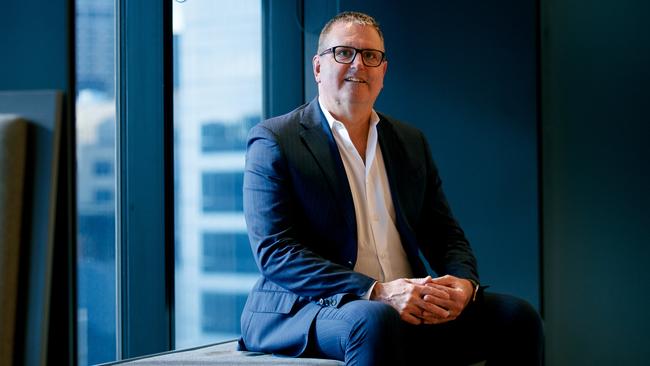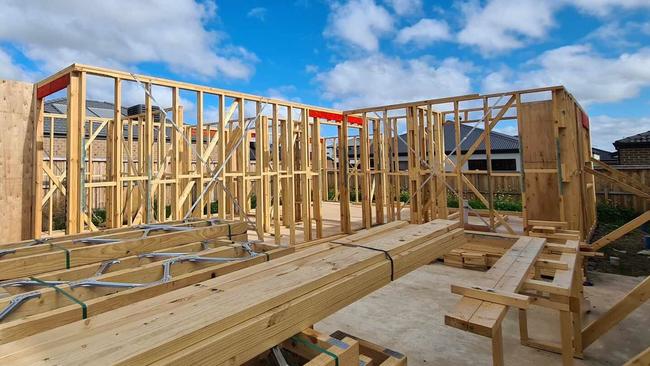Why insurance and inflation are a painful combination as costs run hot
Insurers have been racing to keep ahead of the costs they now face to rebuild a house or repair a car. That’s starting to change.

If you want to get a handle on the direction of inflation and therefore cash rate moves, insurers offer a pretty good clue.
If you chart inflation over the share price of the nation’s biggest home and car underwriter, Insurance Australia Group, and flip one of them upside down, there’s a surprising correlation.
When inverted, inflation has moved in lock-step with IAG shares, although the insurer has a six-month lead.
Futures pricing has the Reserve Bank starting its cash-rate cutting cycle by next February as inflation cools down. And with the IAG share price currently running at a five-year high, that’s sending a pretty strong signal on where inflation is headed next, and that’s down.
IAG chief executive Nick Hawkins is quick to say his insurer is more complicated than that. However, he acknowledges inflation hits the insurance industry among the hardest and has cast a long shadow over the sector since the pandemic. This means Hawkins’ customers that rely on brand like NRMA, RACV and CGU for protection have also felt that financial pain acutely.
Insurers have spent the past few years pushing through double-digit price rises on property and car insurance as they respond to higher construction costs and, more importantly, a surge in reinsurance pricing.
Last year IAG lifted its premiums on average by 16 per cent while the nation’s second-biggest player, Suncorp, raised them by more than 12 per cent.
Insurers have been racing to keep ahead of the costs they now face to rebuild a house or repair a car. The bottom line is insurers sell you a policy today to repair or rebuild your house after some unknown disaster at some unknown point in the future.
“Our business is unusual in we have to sell something before we know what it is going to cost,” Hawkins says.
The good news for customers, the rate of insurance premium increases are definitely slowing (although not falling). Car insurance costs are falling away the quickest, with the supply chain squeeze easing after Covid. However, property insurance is still problematic, with building costs rising.
A push by all levels governments to build hundreds of thousands of new homes is only putting more heat on labour and materials.
In home builds over the past three years, material costs such as plaster and paint have increased about 10 per cent a year, and some trades such as electricians have averaged 8 per cent a year. The demand for new residential developments – largely multi-story apartments – is soaking up the availability. In Victoria, where major infrastructure building is running hot, trade inflation is pushing 18 per cent a year.

Hawkins says this is not just a pressure for insurers, but it’s becoming a bigger problem for the economy as we try to get more people into affordable homes. Ironically, the solution is hurting affordability.
“Building costs are going up 10-15 per cent, what are we doing about that?” he asks.
Hawkins is speaking on a clear and sunny day at IAG’s head office on the edge of Sydney’s CBD. That doesn’t make it any less intensive a day. There are hundreds of daily property claims on smaller jobs such as burst pipes, kitchen fires and theft. A storm is about to hit Melbourne, meaning claims there are likely to spike on roof leaks.
The insurer also repairs on average about 1400 cars involved in an accidents each day. Nearly a quarter of those are processed from IAG’s own repairer network.
With more electronics and sensors being packed into new cars, even simple jobs are becoming more expensive to repair.
Electric vehicles so far make up a fraction of his portfolio and the early lessons are they tend to be more expensive to repair when it involves the electrics. There’s no noticeable trend on EV fires versus combustion motors, other than when they do happen they are more intense. EVs tend to be faster and heavier, which means accident damage is often greater and more costly.
Any discussion with an Australian insurer quickly moves to reinsurance. These are the big global insurers that essentially stand behind the insurers and have the deep pockets to pay out the mega-claims for perils such as flood, bushfires or hail.
Partly through regulation and high rate of perils, Australian insurers are some of the biggest users of global reinsurers. Incredibly, local insurers rank as their top five global customers in some lines. This might be a good thing in helping local players compete with global majors such as Allianz or Zurich. However, being so reliant on imported insurance capital means Australians are much more vulnerable to price rises.
Over the past three years, reinsurance prices have jump 40 per cent as big players have faced rising global payouts on rising frequency of floods and other natural disasters (including in Australia).
Hawkins says this is the most he’s seen in his entire career. IAG has absorbed some and taken on more risk at the lower end of its book to keep costs low. This reinsurance bubble is starting to pass, with pricing starting to stabilise.

Some of Hawkins’ top executives, including NRMA Insurance chief Julie Batch, have just returned from a tour of California taking a close-up look at what is widely regarded as a global model of a dysfunctional insurance market.
The cost of payouts on repeated wildfires have been mounting. But the major thing pushing insurers out of the market has been tough state-based regulations that essentially attempted to cap price rises on customers. This is forcing any remaining insurers to put stricter conditions around what they are prepared to back.
With scrutiny on all business amid claims of price gouging, California is a cautionary tale for Australia.
Hawkins recent full-year results delivered an 8 per cent lift in IAG’s headline profit to $898m. His return on equity is starting to drift higher at 13.5 per cent, and this follows years of it being stuck in the single digits. Hawkins is aiming for a return on equity of between 14 per cent and 15 per cent.
This target represent “a reasonable return to get the balance right” on the risks needed to be taken by a national, full-coverage insurer, Hawkins says.
He says Australian politicians have a good understanding of the role insurance plays in the community after a natural disaster hits. This means it is also important for insurers to be profitable and well capitalised to pay for the perils when they inevitable come – and, like in 2022’s floods, often in quick succession.
This doesn’t mean the industry escapes political scrutiny entirely. But the heat is often around what happens after a crisis, with the handling of claims and speed of repairs.
A parliamentary inquiry looking at the insurance industry response into the floods that hit NSW and Queensland two years ago is due to report in coming weeks. Among recommendations are expected to be demands on the industry to be better prepared with access to basic infrastructure and emergency accommodation when it comes to major events. Communication to customers during disasters and speed of claims and disputes are expected to come under focus.
Hawkins says the key is to keep pulling all the levers to keep insurance costs low for all homeowners.
Here Australia needs to do much more on planning. Many towns were built in all the wrong places and vulnerable to cyclones, flooding or fires. There’s not much we can do about that, but there is a case to invest more on prevention and resilience from disasters when they inevitably hit. Hawkins also recognises he needs to run his own business as efficiently as possible
This is key to keeping insurance affordable for communities that are more vulnerable. After all, insurers see their core business as taking on risk of weather events or unexpected claims like theft and storms and want to be able to keep doing this so communities aren’t left high and dry. “We’re supposed to be the nation’s shock absorber, not the government,” Hawkins says.
Originally published as Why insurance and inflation are a painful combination as costs run hot



